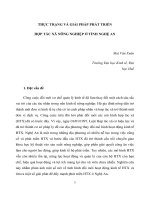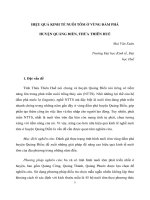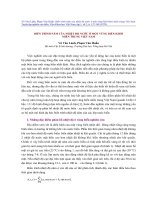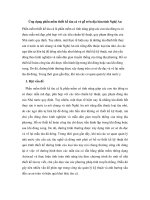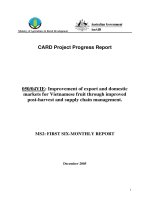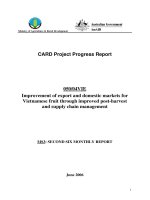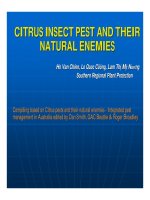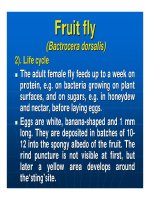Báo cáo nghiên cứu khoa học " MAINTAINING FRUIT QUALITY AND INCREASING SHELF LIFE OF POMELO IN THE MEKONG DELTA OF SOUTHERN VIETNAM " pot
Bạn đang xem bản rút gọn của tài liệu. Xem và tải ngay bản đầy đủ của tài liệu tại đây (1.68 MB, 38 trang )
1
CARD PROJECT 050/04 VIE
Improvement of export and domestic markets for
Vietnamese fruit through improved post-harvest and
supply chain management
MAINTAINING FRUIT QUALITY AND INCREASING SHELF LIFE
OF POMELO IN THE MEKONG DELTA OF SOUTHERN VIETNAM
By Robert Nissen
1
, Nguyen Duy Duc
2
, Ms San Tram Anh
2
, Ms Tran Thi Kim Oanh
2
, Mr Vu Cong
Khanh
2
& Mr Ngo Van Binh
2
,
1
Queensland Department of Primary Industries and Fisheries (DPI&F) , Maroochy Research
Station, PO Box 5083 SCMC, Queensland, Australia, 4560.
2
Southern Sub-Institute of Agricultural Engineering and Post-Harvest Technology (SIAEP), 54
Tran Khanh Du Street, District 1, Ho Chi Minh City, Vietnam.
2
MAINTAINING FRUIT QUALITY AND INCREASING SHELF LIFE
OF POMELO IN THE MEKONG DELTA OF SOUTHERN VIETNAM
Robert Nissen
1
, Nguyen Duy Duc
2
, Ms San Tram Anh
2
, Ms Tran Thi Kim Oanh
2
, Mr Vu Cong Khanh
2
&
Mr Ngo Van Binh
2
,
1
Queensland Department of Primary Industries and Fisheries (DPI&F) , Maroochy Research Station,
PO Box 5083 SCMC, Queensland, Australia, 4560.
2
Southern Sub-Institute of Agricultural Engineering and Post-Harvest Technology (SIAEP), 54 Tran
Khanh Du Street, District 1, Ho Chi Minh City, Vietnam.
INTRODUCTION
In Southern Vietnam, traditional wet market supply chains for agricultural fresh food are now giving way
to new supermarket-led supply chain systems. The rapid transformation in the fruit and vegetables
sector is due to the meteoric rise of supermarkets, hypermarkets, superstores, neighborhood stores,
convenience stores, discount stores in Southern Vietnam. This change is impacting on both the
upstream and downstream agricultural food supply chain participants through demands for safe, high
quality and sustainable-produced fresh products and the greatest impact is being felt by the small
farmers of southern Vietnam. Problems with traditional procurement supply chain practices include
low- or no product standards, supply inconsistencies, highly variable transaction costs and limited or
sequestered market information.
Supermarkets are now setting new procurement practices and supply systems which focus on reducing
costs and improving quality to enable them to sell at lower prices. This will allow them to win over
consumers and obtain a larger share of their target market. The ability of many small farmers,
collectors and wholesalers in the Mekong Delta of Vietnam to meet safe food levels and quality
demands of domestic and overseas supermarkets can only be obtained through investing in
improvements in their production and supply chain practices.
Implementation of new production and post–harvest practices and the modernisation of these supply
chains may prevent some small farmers from participating. Many small farmers will have to develop
risk minimisation strategies, such as forming groups, implementing new crop management and
production systems, improved packaging, more efficient transport methods and handling practices to
provide a safe, competitively priced quality product. Understanding how to develop new supply chains
and where to make changes is essential if farmers and all chain participants are to benefit.
Many farmers are now realising that pomelo is a perishable fruit and traditional chains may have to
change. Pomelo fruit suffer severely from moisture loss. Loading and unloading occurs at the local
markets in the hot sun, speeding up the desiccating of the fruit. This moisture loss changes the fruit
appearance, making the fruit less desirable, affecting its salability. High quality class fruit (extra or
super class fruit and class 1 fruit) are often marketed with stalks attached. This is done to reassure
customers that the fruit they are purchasing fresh produce. These stalks often break off during handling
and transport and also draw moisture from the fruit. Farmers, collectors, traders, packaging agents and
wholesalers estimates of fruit damage is from 1 to 2%, but surveys found that it is often above 10% due
to moisture loss, handling damage and disease attack.
3
Therefore, this CARD Project set up experiments to evaluate the benefits of developing new post-
harvest practices to improved fruit quality by reducing moisture loss for the pomelo supply chains
operating in southern Vietnam.
METHODOLOGY
Because pomelo fruit suffer from the loss of moisture, this CARD project set up an experiment to
reduce this moisture loss and increase shelf life and retail value of pomelo fruit. An anti-transparent
and vacuumed wrapping of fruit in polyethylene bags were trialed to determine if this moisture loss
could be significantly reduced.
The pomelo variety “Nam Roi” was chosen as the variety on which to conduct the experiments. Nam
Roi is famous pomelo variety in Vietnam as the fruit are sought after by many Vietnamese consumers.
It has special fruit qualities such as:-
• seedless
• yellow flesh colour
• the flesh is crisp and sweet
TREATMENTS
Fruit assessments were carried out at the SIAEP laboratory in Ho Chi Minh City. Treatments were
applied to the pomelo fruit and fruit stored on the bench in the laboratory at SIAEP at about 25
o
C.
Mature pomelo fruit purchased from the Thuy Duc Wholesale Markets in Ho Chi Minh City were used in
this experiment. Experimental design consisted of three treatments of 10 fruit per rep sampled every 7
days for 12 weeks. Treatments applied were:
1. Control
2. Citra Shine Special Wax applied to the fruit
• CITRASHINE is a shellac-based wax formulated with purified natural secretion and
water-soluble emulsifying agents. It does not contain any solvents but water and all
ingredients are approved for use on foodstuf by the Health regulations in most
countries. This product is USFDA approved.
• CITRASHINE is stable and anti-transparent and the long-lasting shine which it
provides improves citrus fruit appearance and skin resistance, increasing the fruit
market value. In addition CITRASHINE controls dehydratation and prevents fruit from
excessive weight loss. Fruits were cleaned by detergent deccosol before apply the
wax to remove dirt, dust and foreign material.
3. Vacuum sealed polyethylene plastic film applied to the fruit (wrapping)
• A Lavezzini Vacuum Packaging Systems, Model Boxer was used to wrap and seal the
pomelo fruit in a 0.014 mm Liner Low Density Polyethylene (LLDPE) plastic film.
FRUIT MEASUREMENTS
Assessments undertaken were:
• Average fruit weight in grams and percentage moisture loss over time
• Skin colour change over time using a Minolta Chromometer CR 200 and expressed as L a b
values
• Titrateable Acid measured using 10 grams of flesh in 100ml of double distilled water and
macerated. This solution was then filtered through cotton wool and 10 mls of juice was
collected and 2 drops of phenolphalayene indicator was added and titrated with Sodium
Hydroxide (NaOH) 0.1 normal solution, until colour change occurred.
4
• Total soluble solids or degree Brix, was measured using a temperature compensation hand
held Atago Refractometer Model N-1E.
• Vitamin C content was measured using Association of Analytical Chemists (AOAC)
International method 967.21. Procedure used was:
o Take 10 g of fruit flesh and grind with 5 ml Metaphosphoric-acetic solution.
o Remove all sample and place into a 100ml flask and add Metaphosphoric-acetic
solution until it reaches 100mls and shake
o Filter through absorbent cotton or rapid paper
o Take 10ml of the above solution and place into a 100ml glass beaker
o Titrate this solution with 2,6 diclorophenol indophenolat natri until fast pink colour
appears. This takes about 2 minutes to occur
o Count amount of 2,6 DCPIP need to titrate 1mg acid ascorbic
+ Take 2 ml standard acid ascorbic solution add 5 ml
Metaphosphoric-acetic
+Titrate with 2,6 diclorophenol indophenolat natri until fast pink
colour appears in about 2 minutes (note number ml : y)
o Titrate blank sample with 2,6 diclorophenol indophenolat natri until fast pink colour
appears. This takes about 2 minutes to occur (note number ml = B)
Calculation
Content of Vitamin C =
P
v
VFBX
.
100 ).(
−
(mg/100gram sample)
X: ml 2,6 diclorophenol indophenolat natri titrate sample
V: extracting solution volume ( V = 100ml)
v: extracting solution volume to titrate (v = 7ml)
P: amount of sample ( p = 10 gram)
F: mg ascorbic acid equivalent 1ml standard 2,6 diclorophenol
indophenolat natri
( F=
Y
2
).
• Taste evaluations were carried out by an expert panel of 12 people established at SIAEP
laboratory using the hedonic scale (1-9):-
1 = dislike very much
3 = dislike
5 = neither dislike or like
7 = like
9 = like very much
RESULTS
LOSS IN FRUIT WEIGHT (MOISTURE)
Fruit weight loss was greater for the Control and Vacuum Wrapping treatments compared to the Citra
Shine Special Wax treatment (Figure 1). Moisture loss for the Vacuum Wrapping and Citra Shine
Special Wax treatments was reduced by 13% and 22% respectively compared to the control treatment.
The control treatment and Vacuum Wrapping treatment fruit shelf life was 63 days and the fruit treated
with Citra Shine Special Wax was 77 days.
Control treated fruit at 63 days were extremely shriveled. This was due to sever moisture loss and
disease had affected the internal eating quality of the fruit. The Vacuum Wrapped treated fruit were
5
also shriveled, but the fruit had not desiccated to the same degree as the control treated fruit at day 63.
The Citra Shine Special Wax treated fruit did not reach the same level of desiccation as the Vacuum
Wrapped treated fruit until day 77. The Control treated fruit had the highest rate and the greatest
moisture loss of the three treatments (Figure 2).
Moisture loss followed a power curve (y=a+bx
c
) pattern for all treatments. See Figures 2, 3 and 4
below.
Day
1 7 14 21 28 35 42 49 56 63 70 77
Moisture loss (%)
0
10
20
30
40
Control
Citra Shine Special
Vacuum Wrapping
Figure 1. Comparison of percentage moisture loss in Nam Roi Pomelo fruit between control, Citra
Shine Special Wax and Vacuum Wrap treatments.
6
Days
0 7 14 21 28 35 42 49 56 63 70 77
Moisture loss (%)
0
10
20
30
40
Control
(power) y=a+bx
c
r
2
0.9989934473
a=-3.15094878
b=3.139496644
c=0.602550012
Figure 2. Control treatment, fruit moisture loss over time
Days
0 7 14 21 28 35 42 49 56 63 70 77
Moisture loss (%)
0
10
20
30
40
Citra Shine Special Wax
(power) y=a+bx
c
r
2
=0.99056254
a=-2.33936990
b=2.072603593
c=0.672818004
Figure 3. Citra Shine Special Wax treatment, fruit moisture loss over time
7
Citra Shine Special Wax
x column vs y column
Days
0 7 14 21 28 35 42 49 56 63 70 77
Moisture loss (%)
0
10
20
30
40
Vacuum Wrapping
(power) y=a+bx
c
r
2
=0.9910450338
a=-2.33936990
b=2.072603593
c=0.672818004
Figure 4. Vacuum wrapping treatment, fruit moisture loss over time
End of shelf life is based on external appearance and the characteristics used are:
• fruit have a soft leathery feel
• fruit are highly shriveled due to moisture loss
• neck of the fruit is sunken and more pronounced
• skin colour changes from bright yellow colour to a dull deeper yellow
• disease area on infected fruit increase in size rapidly.
Internal appearance indicators for end of shelf life is:-
• internal browning of the segments and albedo
• juice sacks are soft and spongy
• juice sacks are not easily separated from the segment
• disease areas are visible in the flesh.
8
Figure 5. Control treated fruit day1.
Figure 6. Citra Shine Special Wax treated fruit
day 1.
Figure 7. Vacuum Wrapped treated fruit day 1.
9
Figure 8. Control treated fruit day 63.
Figure 9. Citra Shine Special Wax treated fruit day 63.
10
Figure 10. Vacuum wrapped treated fruit day 63.
11
COLOUR READINGS
Minolta Chromameter CR 200 was used to determine skin colour changes of the sampled fruit. The
colour space measurements are:- L* (positive values indicate lightness and negative values indicate
darkness), a* (positive values indicate red as opposed to negative values indicate green), and b*
(positive values indicate yellow and negative values indicate blue).
Figure 11. L* a* b* colour space difference ∆E* ab
Lightness 25% Lightness 50% Lightness 75%
Figure 12. Colour diagrammatic representation of L* a* b* colour space values
Note: Colour show here may not be a true representation of colour observed by the naked eye as these colours patches are
dependent computer, screen and printer settings used to display or print this report.
S
KIN COLOUR READINGS
Traders, collectors, packing agents, wholesalers, retailers and consumers look at the skin colour, and
use this as one of the determinates of fruit maturity and ripeness. Therefore, in this experiment we
have tried to establish the effects of the anti-transparent and vacuum wrapping on skin colour.
12
Survey work conducted by the CARD Project 05004/ VIE found:
• Wholesalers prefer to purchase Nam Roi pomelo fruit that are light green in colour, as this they
regard this as a sign of freshness and maturity. If fruit are too yellow they are regarded as
being overripe. IF fruit are too green, they are
• Wholesalers also prefer to purchase class 1 pomelo fruit with stalks (>10cm) and leaves
attached, this is a sign of freshness
• Under high temperature conditions in Vietnam pomelo fruit ripen quickly, lose moisture and
shrivel, then breakdown due to disease (fruit rots)
Table 2 provides a comparison of representative colour space over time taken of the Control, Citra
Shine Special Wax and Vacuum Wrapping treatment fruit.
Table 2. Skin colour readings from day 1 to day 77 for treatments applied for Nam Roi Pomelo.
Day Control Citra Shine Special Wax Vacuum Wrapping
1
Readings L* 51.67; a* -15.85; b* 29.57 L* 53.63; a* -16.17; b* 29.75 L* 58.82; a* -12.41; b* 21.83
7
Readings L* 52.18; a* -15.70; b* 31.43 L* 56.91; a* -15.43; b* 32.36 L* 59.22; a* -12.36; b* 22.95
14
Readings L* 54.09; a* -15.82; b* 32.48 L* 54.58; a* -15.40; b* 31.30 L* 59.86; a* -12.03; b* 24.42
21
Readings L* 56.31; a* -15.09; b* 35.40 L* 57.27; a* -16.12; b* 33.82 L* 61.22; a* -12.42; b* 25.15
28
Readings L* 58.77; a* -15.03; b* 38.20 L* 58.17; a* -15.15; b* 34.41 L* 61.39 a* -12.35; b* 25.75
13
Table 2 (cont). Skin colour readings from day 1 to day 77 for treatments applied for Nam Roi Pomelo.
Day Control Citra Shine Special Wax Vacuum Wrapping
35
Readings L* 59.11; a* -13.49; b* 39.99 L* 59.24; a* -15.06; b* 36.49 L* 62.02; a* -11.36; b* 27.56
42
Readings L* 62.35; a* -11.12; b* 43.65 L* 61.56; a* -14.04; b* 37.83 L* 62.63; a* -10.66; b* 28.26
49
Readings L* 63.79; a* -9.09; b* 47.27 L* 61.57; a* -13.06; b* 39.12 L* 58.87; a* -8.89; b* 27.18
56
Readings L*64.58; a* -6.80; b* 47.77 L* 62.55; a* -10.97; b* 40.98 L* 67.44; a*-7.65 ; b* 34.38
63
Readings L* 64.78; a* -4.32; b* 48.85 L* 66.09; a* -8.27; b* 45.40 L* 68.81; a* -5.67; b* 36.79
70
Readings L* 64.16; a* -6.13; b* 45.22
77
Readings L* 68.02; a* -3.18; b* 50.16
The Vacuum Wrapped treated fruit reach a similar skin colour 7 days (1 week) after the Control Treated
fruit (Table 2). Fruit treated with Citra Shine Special Wax reach a similar yellow skin colour 14 days (2
weeks) later than the Control treated fruit (Table 2). Therefore, based on skin colour, the Citra Shine
Special Wax increased the fruit shelf life by 2 weeks and the Vacuum Wrapping increased shelf life by 1
week.
All citrus are non-climacteric fruit, meaning that they ripen gradually over weeks or months. External
color changes during ripening, but is a function of climate more than ripeness, and a very poor indicator
of maturity. The best indices of maturity for citrus are internal Total Soluble Solids (
o
Brix or sugar),
Titrateable acid content (acid), and the
o
Brix/acid ratio.
14
S
KIN L* COLOUR SPACE
We found the L* colour space readings for fruit that were Vacuum Wrapped in a liner of low-density
polyethylene plastic film were very slightly altered were due to the reflective nature of the plastic if fruit
were measured with the wrapping plastic on.
Fruit from all treatments ripened and the skin colour changed from a darker colour (green) to lighter,
brighter (Yellow) colour with no adverse affects. Fruit of the Vacuum Wrapping treatment did not
change to a lighter colour at the same rate as the Control and Citra Shine Special Wax treated fruit
(Figure 13). The Control, Citra Shine Special Wax and Vacuum Wrapped treatments were straight line
linear relationships (y=a+bx). See Figures 14, 15 and 16. Initially, the change from a darker colour to a
lighter colour was constant for all treatments from day 1 to day 14. The Vacuum Wrapping treatment
rate of change slowed until day 49, then increased rapidly to a lighter colour from day 49 to day 63
(Figure 13).
Days
0 7 14 21 28 35 42 49 56 63 70 77
L* colour Space
50
52
54
56
58
60
62
64
66
68
70
Control
Citra Shine Special
Vacuum Wrapping
Figure 13. Comparison of the average L* colour space values for the Control, Citra Shine Special Wax
and Vacuum Wrapping Treatments for Nam Roi Pomelo.
15
Days
0 7 14 21 28 35 42 49 56 63 70 77
L* colour space
50
55
60
65
70
y=a+bx
r
2
=0.9763023534
a=51.45446086
b=0.233276555
Control
Figure 14. Control treatment L* colour space change over time
Day vs Traditional method
Days
0 7 14 21 28 35 42 49 56 63 70 77
L* colour space
50
55
60
65
70
y=a+bx
r
2
=0.9808400384
a=52.613986
b=0.19952952
Citra Shine Special Wax
Figure 15. Citra Shine Special Wax treatment L* colour space change over time
16
Days
0 7 14 21 28 35 42 49 56 63 70 77
L* colour space
50
55
60
65
70
Vacuum Wrapping
y=a+bx
r
2
=0.8837896690
a=57.78614059
b=0.148571500
Figure 15. Vacuum Wrapping treatment L* colour space change over time
17
S
KIN A* COLOUR SPACE
For the a* colour space (red to green), the Control and Vacuum Wrapped treated fruit remained green
until day 28 when the fruit lost the green colour and change to a light yellow colour (Figure 16). All
three treatments had similar power curve relationships. The Control treatment changed in colour was
slow until day 28, and then increased rapidly until day 63 (Figure 17). The Citra Shine Special Wax
treatment increased slowly until day 2, and then increased rapidly until day 77 (Figure 18). The
Vacuum Wrapping was the slowest and slowly increased until day 35 and then increased rapidly until
day 63 (Figure 19).
Days
0 7 14 21 28 35 42 49 56 63 70 77
a* colour space
-18
-16
-14
-12
-10
-8
-6
-4
-2
Control
Citra Shine Special Wax
Vacuum Wrapping
Figure 16. Comparison of the average a* colour space values for the Control, Citra Shine Special Wax
and Vacuum Wrapping Treatments for Nam Roi Pomelo.
18
Days
0 7 14 21 28 35 42 49 56 63 70 77
a* colour space
-20
-15
-10
-5
0
(power)y=a+bx
c
r
2
=0.99255473
a=-16.029398
b=0.0005508
c=2.4113227
Control
Figure 17. Control treatment a* colour space change over time
Days
0 7 14 21 28 35 42 49 56 63 70 77
a* colour space
-20
-15
-10
-5
0
(power)y=a+bx
c
r
2
=0.96121494
a=-15.867733
b=0.00011966
c=2.66249
Citra Shine Special Wax
Figure 18. Citra Shine Special Wax treatment a* colour space change over time
19
Days
0 7 14 21 28 35 42 49 56 63 70 77
a* colour space
-20
-15
-10
-5
0
(power)y=a+bx
c
r
2
=0.98863022
a=-12.452764
b=0. 673678e-06
c=3.1207941
Vacuum Wrapping
Figure 19. Vacuum Wrapping treatment a* colour space change over time
20
S
KIN B* COLOUR SPACE
For the b* colour space readings, all three treatments had a straight line linear relationship and
changed colour from blue to yellow colour (Figure 20). The skin b* colour space for the Control treated
fruit changed from green to full yellow in 49 days (Figure 21), the Vacuum Wrapping fruit changed from
green to full yellow in 56 days (Figure 22) and the Citra Shine Special Wax treated fruit changed from
green to full yellow in 63 days (Figure 23).
Days
0 7 14 21 28 35 42 49 56 63 70 77
b* colour space
25
30
35
40
45
50
55
Control
Citra Shine Special Wax
Vacuum Wrapping
Figure 20. Comparison of the average b* colour space values for the Control, Citra Shine Special Wax
and Vacuum Wrapping Treatments for Nam Roi Pomelo.
21
Days
0 7 14 21 28 35 42 49 56 63 70 77
b* colour space
25
30
35
40
45
50
55
y=a+bx
r
2
=0.98358781
a=28.74766
b=0.330902975
Control
Figure 21. Control treatment b* colour space change over time
Days
0 7 14 21 28 35 42 49 56 63 70 77
b* colour space
25
30
35
40
45
50
55
y=a+bx
r
2
=0.95109987
a=28.564892
b=0.2463527
Citra Shine Special Wax
Figure 22. Citra Shine Special Wax treatment b* colour space change over time
22
Days
0 7 14 21 28 35 42 49 56 63 70 77
b* colour space
25
30
35
40
45
50
55
y=a+bx
r
2
=0.91038995
a=20.7378876
b=0.218001025
Vacuum Wrapping
Figure 23. Vacuum Wrapping treatment b* colour space change over time
23
T
OTAL SOLUBLE SOLIDS (TSS) OR DEGREE BRIX (
O
BRIX)
For this experiment, no relationships could be established between time and change in Total Soluble
Solids (
o
Brix). Figure 24 shows the Control treatment reaching a peak of 13
o
Brix on day 49 then
dropping sharply to 9
o
Brix on days 56 and 63. This drop was due to the fruit being over ripe and
breaking down internally. The Citra Shine Special Wax and Vacuum Wrapping treatments
o
Brix levels
continued to rise from day 1 reaching 12
o
Brix, even when the fruit had reach the end of their shelf life
on day 63 and day 77 respectively (Figure 24).
Days
0 7 14 21 28 35 42 49 56 63 70 77
Total Solulable Solids (Brix
O
)
8
9
10
11
12
13
14
Control
Citra Shine Special Wax
Vacumm Wrapping
Figure 24. Comparison of the average Total Soluble Solids (
o
Brix) for the Control, Citra Shine Special
Wax and Vacuum Wrapping Treatments for Nam Roi Pomelo.
T
ITRATEABLE ACID CONTENT OF FLESH (TA, %)
For this experiment no relationships between time and change in titrateable acid content of the flesh
was established. For all treatments fruit acid initially increased then dropped sharply. The decrease in
acid content is consistent with the literature on post-harvest ripening process of citrus fruit. The acid is
used in the respiration process for preserving the citrus fruit.
The Control treatment fruit increased in acidity by 16%, peaking on day 21. Fruit then slowly decreased
by 3% on day 35. The acidity then dropped sharply by 11% on day 42 before dropping sharply again
by 20% on day 63 (Figure 25).
Fruit treated with Vacuum Wrapping also increased in acid by 16% on day 14, peaking at 0.86% acid.
Fruit then slowly decreased by 6% on day 21, stabilised for 3 weeks before dropping sharply by 25% to
reach a low on day 63.
The Citra Shine Special Wax treated fruit had a significantly lower acidity. The initial rate of increase
was only half that of the Control and Vacuum Wrapping treatments. The acidity level for this treatment
24
peaked at 0.79%, about 9% lower that the Control and Vacuum Wrapping treatments. The acid level
decreased at a slower rate compared to the Control and Vacuum Wrapping treatments. Fruit acid then
decreased by 25% to be 0.60% on day 77. The amount of decrease is similar to the decrease in acidity
for the Control and Vacuum Wrapping treatments, 20% and 25% respectively.
Days
0 7 14 21 28 35 42 49 56 63 70 77
Titrateable Acid (%)
0.55
0.60
0.65
0.70
0.75
0.80
0.85
0.90
Day vs Control
Day vs Citra Shine Special Wax
Day vs Vacuum Wrapping
Figure 25. Comparison of the average Titrateable Acid Content of Flesh (TA, %) for the Control, Citra
Shine Special Wax and Vacuum Wrapping Treatments for Nam Roi Pomelo.
V
ITAMIN C CONTENT (MG/100G)
Vitamin C (ascorbic acid), is one of the most important vitamins found in citrus juices. Temperature and
storage time affects Vitamin C content of the pomelo juice. Fructose one of the major sugars found in
orange juice, can also cause Vitamin C breakdown. The higher the fructose content the greater the
loss of Vitamin C in the fruit. Conversely, higher acid levels of citric and malic acids will stabilize
Vitamin C levels.
For this experiment, power curve relationships between time and change in Vitamin C content of the
flesh was established for the Control and Citra Shine Special Wax Treatments (Figure 23 and 24). For
the Vacuum Wrapping treatment, no relationships could be established.
25
Days
0 7 14 21 28 35 42 49 56 63 70 77
Vitamin C content (mg/100g)
46
48
50
52
54
56
58
Control
Citra Shine Special Wax
Vaccum Wrapping
Figure 15. Comparison of the average Vitamin C content (mg/100g) between treatments for Nam Roi
Pomelo.
For the Control treatment the Vitamin C content starting at 50.79mg/100g and by day 63, increased
11% to 56.61mg/100g. The Citra Shine Special Wax treatment dropped slightly, from 50.79 mg/100g
on day 1 to 49.43mg/100g on days 35 to 42, before increasing 12% to 57.15mg/100g on day 77. The
Vacuum Wrapping treatment remained at about 50.5 mg/100g for the firs 3 weeks (days 7, 14 and 21)
before rising to a peak on day 35 of 52.9mg/100g then falling 15% to a low of about 45mg/100g on
days 56 and 63.
